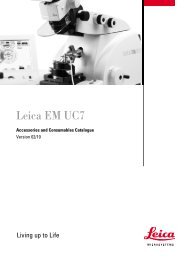Physical Principles of Electron Microscopy: An Introduction to TEM ...
Physical Principles of Electron Microscopy: An Introduction to TEM ...
Physical Principles of Electron Microscopy: An Introduction to TEM ...
Create successful ePaper yourself
Turn your PDF publications into a flip-book with our unique Google optimized e-Paper software.
The Transmission <strong>Electron</strong> Microscope 67<br />
Boersch effect) because <strong>of</strong> the electrostatic interaction between electrons at<br />
“crossovers” where the beam has small diameter and the electron separation<br />
is relatively small. Larger �E leads <strong>to</strong> increased chromatic aberration<br />
(Section 2.6) and a loss <strong>of</strong> image resolution in both the <strong>TEM</strong> and SEM.<br />
3.2 <strong>Electron</strong> Acceleration<br />
After emission from the cathode, electrons are accelerated <strong>to</strong> their final<br />
kinetic energy E0 by means <strong>of</strong> an electric field parallel <strong>to</strong> the optic axis. This<br />
field is generated by applying a potential difference V0 between the cathode<br />
and an anode, a round metal plate containing a central hole (vertically below<br />
the cathode) through which the beam <strong>of</strong> accelerated electrons emerges.<br />
Many <strong>of</strong> the accelerated electrons are absorbed in the anode plate and only<br />
around 1% pass through the hole, so the beam current in a <strong>TEM</strong> is typically<br />
1%<br />
<strong>of</strong> the emission current from the cathode.<br />
To produce electron acceleration, it is only necessary that the anode be<br />
positive relative <strong>to</strong> the cathode. This situation is most conveniently arranged<br />
by having the anode (and the rest <strong>of</strong> the microscope column) at ground<br />
potential and the electron source at a high negative potential (�V0). Therefore<br />
the cathode and its control electrode are mounted below a high-voltage<br />
insula<strong>to</strong>r (see Fig. 3-1) made <strong>of</strong> a ceramic (metal-oxide) material, with a<br />
smooth surface (<strong>to</strong> deter electrical breakdown) and long enough <strong>to</strong> withstand<br />
the<br />
applied high voltage, which is usually at least 100 kV.<br />
Because the thermal energy kT is small (



